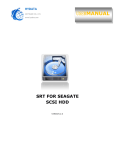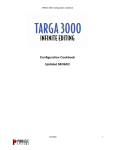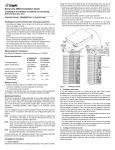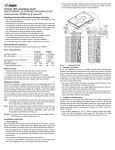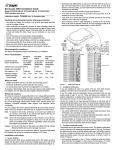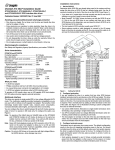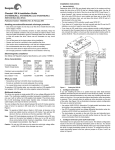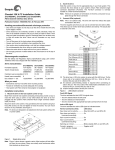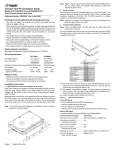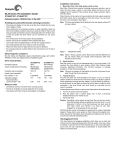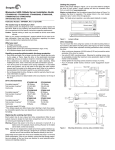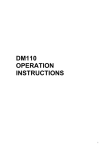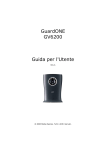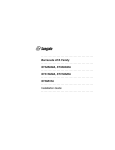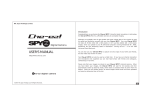Download Seagate ST318451LW Installation guide
Transcript
Installation instructions 1. Set the SCSI ID Determine which SCSI IDs are already being used in the system and then assign this disc drive a SCSI ID that isn’t already being used. Use the J6 connector located on the front of the drive to set the SCSI ID (see Figure 1). Cheetah X15 Installation Guide ST318451LW/LC and ST39251LC SCSI interface disc drives Publication Number: 83329485, Rev. B, September 2000 Handling precautions/Electrostatic discharge protection • Disc drives are fragile. Do not drop or jar the drive and handle the drive only by the edges or frame. • Drive electronics are extremely sensitive to static electricity. Keep the drive in its antistatic container until you are ready to install it. Wear a wrist strap and cable connected to ground. Discharge static from all items near or that will contact the drive. Never use an ohmmeter on any circuit boards. • Turn off the power to the host system during installation. • Always use forced-air ventilation when operating the drive. • Use caution when troubleshooting a unit that has voltages present. • Do not disassemble the drive; doing so voids the warranty. • Return the entire drive for depot service if any part is defective. • Do not apply pressure or attach labels to circuit board or drive top. Electromagnetic compliance See Safety and Regulatory Agency Specifications, p/n 75789512. • Most Cheetah X15 drives are factory set with the SCSI ID set at 0. If this is the only SCSI drive in your system and there are no other SCSI devices on the daisychain, you can leave this drive’s SCSI ID set to 0 and proceed to the next step. • The host system’s SCSI controller usually uses SCSI ID 7. • If you have an LC model drive, the host normally sets the ID over the I/O interface, so you don’t need to worry about this step. • Some systems provide a cable designed to connect to the J5 jumper block on the drive to remotely set the ID. You can connect this cable to J5 and use the host-provided remote switch to set the SCSI ID. Drive Front Drive HDA Rear Jumper Plug (enlarged to show detail) Pin 1 ST318451 Formatted capacity .................................... 18.35 Gbytes Max. data blocks ....................................... 35,843,670 (0222EE56h) Cylinders and heads (user accessible) ...... 10,377 / 10 heads Disc rotation ............................................... 15k rpm +5V Typical operating current ......................... 0.8A +12V 1.03A ST39251 Formatted capacity .................................... 9.2 Gbytes Max. data blocks ....................................... 17,921,835 (0111772Bh) Cylinders and heads (user accessible) ...... 10,377 / 5 heads Disc rotation ............................................... 15k rpm Operating voltages +5V Ground Pin 1 J5 Pin 1 J1 DC Power J6 Drive characteristics Operating voltages 68 Pin SCSI I/O Connector +5V Typical operating current ......................... 0.79A +12V Reserved SCSI ID = 0 L R E E D S 4P A3 A2 A1A0 (default) • Phillips screwdriver and four 6-32 UNC drive mounting screws • Forced-air ventilation to provide adequate drive cooling • An unused drive power connector (not applicable to LC models) To operate at LVD transfer rates, you may also need an LVD-capable SCSI host adapter, LVD I/O cable and active negation external terminator Multimode interface This drive can operate in single-ended (SE) or low voltage differential (LVD) mode. This multimode capability provides backwards compatibility so you can use it with or without an LVD-capable host adapter. The primary benefits of LVD technology include faster transfer rates, reduced power consumption, increased allowable cable lengths, and improved device connectivity. You can configure the drive to switch between SE and LVD modes automatically or force it to operate in SE mode only. To configure this option, see Figure 2. Note. To operate at the Ultra2 rates in LVD mode, all devices on the same bus (cable) must be running in LVD mode. If you add any SE device to the bus, all devices on that bus operate in SE mode. Note. Some LVD host adapters provide an LVD connector and an SE connector on the same host adapter to allow you to run SE and LVD drives concurrently at their maximum capabilities. Check your SCSI host adapter documentation. See Figure 3. Caution. Do not mix LVD drives on the same bus with high voltage differential (HVD) devices–drive damage may occur. SCSI ID = 0 (default) PCBA SCSI ID = 2 SCSI ID = 2 SCSI ID = 3 SCSI ID = 3 SCSI ID = 4 SCSI ID = 4 SCSI ID = 5 SCSI ID = 5 SCSI ID = 6 SCSI ID = 6 SCSI ID = 7 SCSI ID = 7 SCSI ID = 8 SCSI ID = 8 SCSI ID = 9 SCSI ID = 9 SCSI ID = 10 SCSI ID = 11 SCSI ID = 12 SCSI ID = 13 SCSI ID = 14 SCSI ID = 15 SCSI ID = 10 SCSI ID = 11 SCSI ID = 12 SCSI ID = 13 SCSI ID = 14 SCSI ID = 15 not used 0.93A What you need 1P SCSI ID = 1 SCSI ID = 1 Figure 1. 3P 2P J1 A3 A2 A1A0 Setting the SCSI ID 2. Configure termination If you are installing the drive in a system that has other SCSI devices installed, terminate only the end devices on the SCSI bus (cable). This drive does not have internal terminators or any other way of adding internal termination on the drive. You must provide external termination when termination is required. This is normally done by adding an inline terminator on the end of the cable. See Figure 3 for an illustration showing a system configuration that uses a external terminator. • Use active (ANSI SCSI-2 Alternative 2) single-ended terminators when terminating a bus operating in single-ended mode. • Use SPI-2-compliant active low voltage differential terminators when terminating a SCSI Ultra2 bus operating in LVD mode. • The host adapter is normally on the end of the bus and internally terminated. You can configure your bus with another device on the end if you remove termination from the host adapter. 3. Configure terminator power Terminators have to get power from some source. The default configuration results in the drive not supplying termination power to the bus. You should normally leave this drive set at this default unless your host system requires the drive to supply termination power to the bus. To configure this drive to supply termination power to the bus, place a jumper on J2 pins 1 and 2 as shown in Figure 2. • Host systems designed to use LC drives normally provide termination power from the host adapter or other source. For this reason, LC model drives cannot be configured to provide termination power to the bus. J2 Drive with HDA up, PCB down, viewed from front Pin 1 HDA Protect against power failure or other power interruptions during the format. Reserved Positions Delay Motor Start option (valid only if the Enable Motor Start jumper is not connected) J6 Reserved inoperable. A low level format, with verify turned on, will typically take two hours. Pin 1 L R E EA A A A D S 3 2 1 0 (default) Disable the Delay Motor Start option. Motor start delay equal to the SCSI ID multiplied by 12 seconds. Reserved 11 Remote LED Motor Start option 12 CATH Shipped with cover installed. Do not remove. Do not install jumpers on these four positions. Disable motor start (default). The drive starts according to the Delay Motor Start option. (default) Enable motor start. The drive waits for the Start Unit command from the host before starting the spindle motor. J6 Jumper Drive Front J6 Write Protect option Write protect = Off (enables writing). (default) Write protect = On (disables writing). Pin 1 End Parity Check option (default) Enable parity check of SCSI bus. J2 Disable parity check. Pin 1 Single-ended I/O A jumper here forces single-ended I/O operation. DC Power Connector J1 J2 Jumper SCSI I/O Connector No jumper allows host to select either single-ended or LVD operation. (default) Option select jumpers. 5. Check the other available jumper settings Select other options on J2 as illustrated in Figure 2. Do not change these unless instructed to do so by the host system documentation. 6. Mount the drive in the host system and connect cables Note. LC drives are designed to be attached to a carrier or tray and inserted into the host system without I/O or power cables. a. Mount LW model drives to the host system’s chassis using four 6-32 UNC screws. Two mounting holes are in each side of the drive and there are four mounting holes in the bottom of the drive. Do not over-tighten or force the screws. You can mount the drive in any orientation. b. Connect the SCSI I/O cable into the drive’s SCSI connector. Take care not to stretch or crimp this cable, and do not block the system’s cooling air flow with the cable. Note. For Ultra2 and faster operation, special twisted pair LVD cables are required. Connect the DC power cable to the drive. See Figure 3. Ultra160 or Ultra2 LVD bus segment Pin 1 (check your adapter for Pin 1 location) SCSI LVD/SE SCSI SPI-2 compliant active LVD external terminator on the end of the cable Twisted Pair LVD Cable • MicrosoftTM. Set the drive type in CMOS to “Zero,” “None,” or “No hard drive installed.” Use FDISK.EXE and FORMAT.EXE. Systems using Windows 98 or later can create one single partition (drive letter) on the drive. • MacintoshTM. Use a third-party drive utility (most revisions of Apple’s HD Setup utility only work with drives having special Apple firmware). Troubleshooting 4. Connect the drive activity LED (optional) Connect the Drive Activity LED cable to J6 pins 11 and 12 (see Figure 2), or connect a drive ID and Drive Activity LED cable to J5, depending on host system requirements. c. Caution. Formatting a drive erases all user data. Be sure that you understand this principle before formatting any hard disc drive. It is not necessary to format a drive that previously has been used to store data, unless your intention is to erase all user data. Seagate is not responsible for lost user data. Cheetah X15 disc drives are designed to operate with a variety of operating systems. Please refer to your system or SCSI controller manual for information about formatting and setting up the drive. Some quick desktop system notes are provided below. (default) Terminator Power Term. Power to SCSI Bus Host adapter or other device provides term. power to external terminator. Figure 2. a. Turn on DC power to the host system. b. Boot the system from a system floppy, CD, or from a previously installed hard disc drive if there is one. c. Format the drive. SE Host Adapter PCB • Drive does not spin up. Check cables and all jumper settings. Make sure cable pin 1 (edge stripe) matches PCB pin 1. • Drive spins, but no LED on/off activity. Check SCSI ID setting. Set the ID so that each device on the SCSI chain has its own unique ID. See also the next item below. Host I/O controller is usually ID7. • Computer does not seem to recognize the drive. Verify that the drive is enabled by the SCSI host adapter setup utility. • FDISK does not detect the drive. Run the FDISK program located on your Windows startup diskette. Type fdisk/status to verify that your hard drive is present. Seagate support services For online information about Seagate products, visit www.seagate.com or email your disc questions to [email protected] If you need help installing your drive, consult your dealer first. If you need additional help, call a Seagate technical support specialist. Before calling, note your system configuration and drive model number (ST318451LW or ST318451LC). Africa Australia Austria Belgium Denmark France Germany Hong Kong Ireland Italy Middle East Netherlands Norway +31-20-316-7222 +61-2-9725-3366 0 800-20 12 90 0 800-74 876 80 88 12 66 0 800-90 90 52 0 800-182 6831 800-90-0474 1 800-55 21 22 800-790695 +31-20-316-7222 0 800-732-4283 800-113 91 Poland Spain Sweden Switzerland Singapore Taiwan Turkey United Kingdom USA/Canada/ Latin America Other European countries 00 800-311 12 38 900-98 31 24 0 207 90 073 0 800-83 84 11 +65-488-7584 +886-2-2514-2237 00 800-31 92 91 40 0 800-783 5177 1-800 SEAGATE or +1-405-936-1234 +31-20-316-7222 Warranty. Contact your place of purchase or our web site (above). Return Merchandise Authorization (RMA). Before returning the drive, verify that it is defective. Seagate Worldwide customer service centers are the only facilities authorized to service Seagate drives. Contact nearest center for return procedures and trade regulations. Shipping the drive Caution. Back up the data before shipping. Seagate assumes no responsibility for data lost during shipping or service. Shipping drive in an unapproved container voids the warranty. Pack the drive with original box and packing materials. Use no other materials. This prevents electrical and physical damage in transit. Ultra SCSI SE bus segment Figure 3. Cable connections and external termination 7. Format the drive The drive has been low level formatted at the factory. You do not need to perform another low level format on this drive unless you decide to perform certain diagnostics through the host adapter. If you do decide to perform a low level format, do not abort the format as this is likely to make the drive © 2000 Seagate Technology, LLC All rights reserved Publication number: 83329485, Rev. B, September 2000, Printed in U.S.A. Seagate, Seagate Technology, the Seagate Logo, and Cheetah are either registered trademarks or trademarks of Seagate Technology, LLC. All other trademarks are the property of their respective owners.


